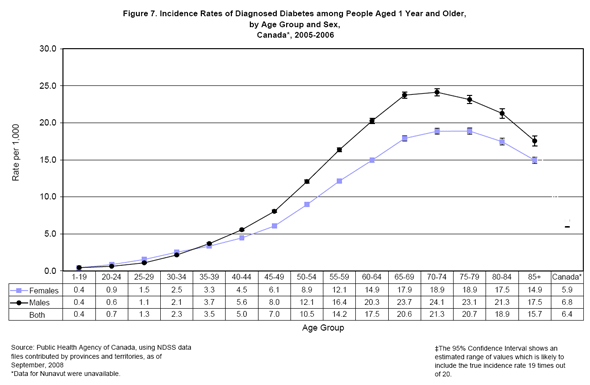Common menu bar links
Institutional links
Diseases & Conditions
Health & Safety
Research & Statistics
Agency Information
Search Box
E-mail this page
Report from the National Diabetes Surveillance System: Diabetes in Canada, 2008
[Previous] [Table of Contents] [next]
People With Newly Diagnosed Diabetes (Incidence8)
For People Aged 1 Year and Older:
- In 2005-2006, 199,471 individuals were newly diagnosed with diabetes - a rate8 of 6.4 per 1,000 population aged 1 and older, overall, and 5.9 per 1,000 among girls and women and 6.8 per 1,000 among boys and men. (Tables 1, 2, and Figure 7)
- In 2005-2006, incidence rates8 of diagnosed diabetes were lower for children and adolescents than for adults. The rates rose steeply after age 45 and peaked among both men and women in the 70-74 age group. The rates were significantly higher among men than women over age 40. (Table 2 and Figure 7)
- After adjusting6 to account for changes in the age distributions across time, the incidence rates8 of diagnosed diabetes have increased by about 7% between 2001-2002 and 2005-2006. (Figure 8) Rising age-standardized incidence rates8 are likely a reflection of the rising prevalence of obesity. In addition, age-standardized prevalence5 is climbing at 3 times the rate of age-standardized incidence rates8, indicating that the increase in prevalence is also due, in part, to improved survival among individuals with diabetes.
Figure 7. Incidence Rates of Diagnosed Diabetes among People Aged 1 Year and Older, by Age Group and Sex, Canada*, 2005-2006

Figure 8. Age-Standardized Incidence Rates* of Diagnosed Diabetes among People Aged 1 Year and Older, by Sex, Canada^, 2001-2002 to 2005-2006

- The proportion of a individuals that are affected by diagnosed diabetes at a given point in time.
- For a more detailed explanation of the age-standardization technique, refer to the methods for this report on the NDSS website: www.ndss.gc.ca.
- These statistics were calculated using estimates for future populations from Statistics Canada and the assumption that both future NDSS incidence and mortality rates remain constant.
- The rate of individuals newly diagnosed with diabetes during the year.
[Previous] [Table of Contents] [next]
